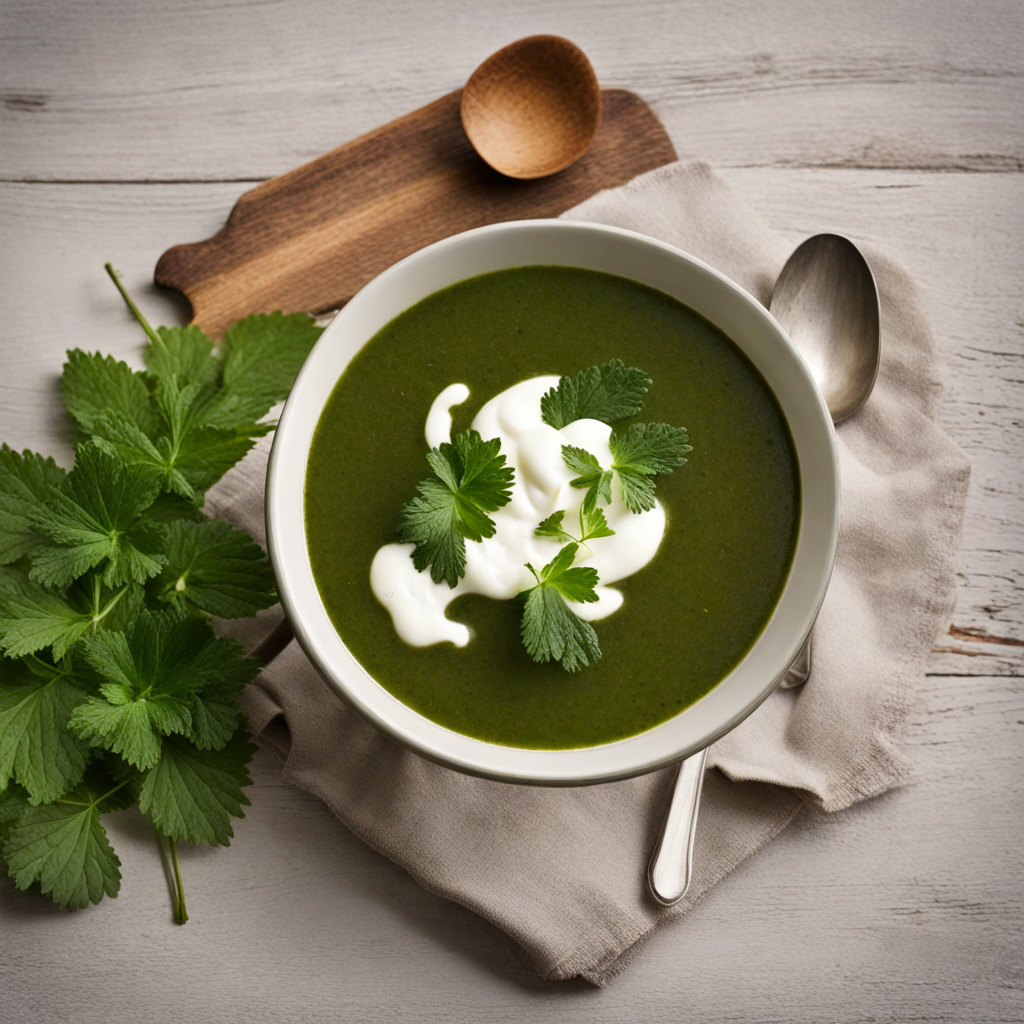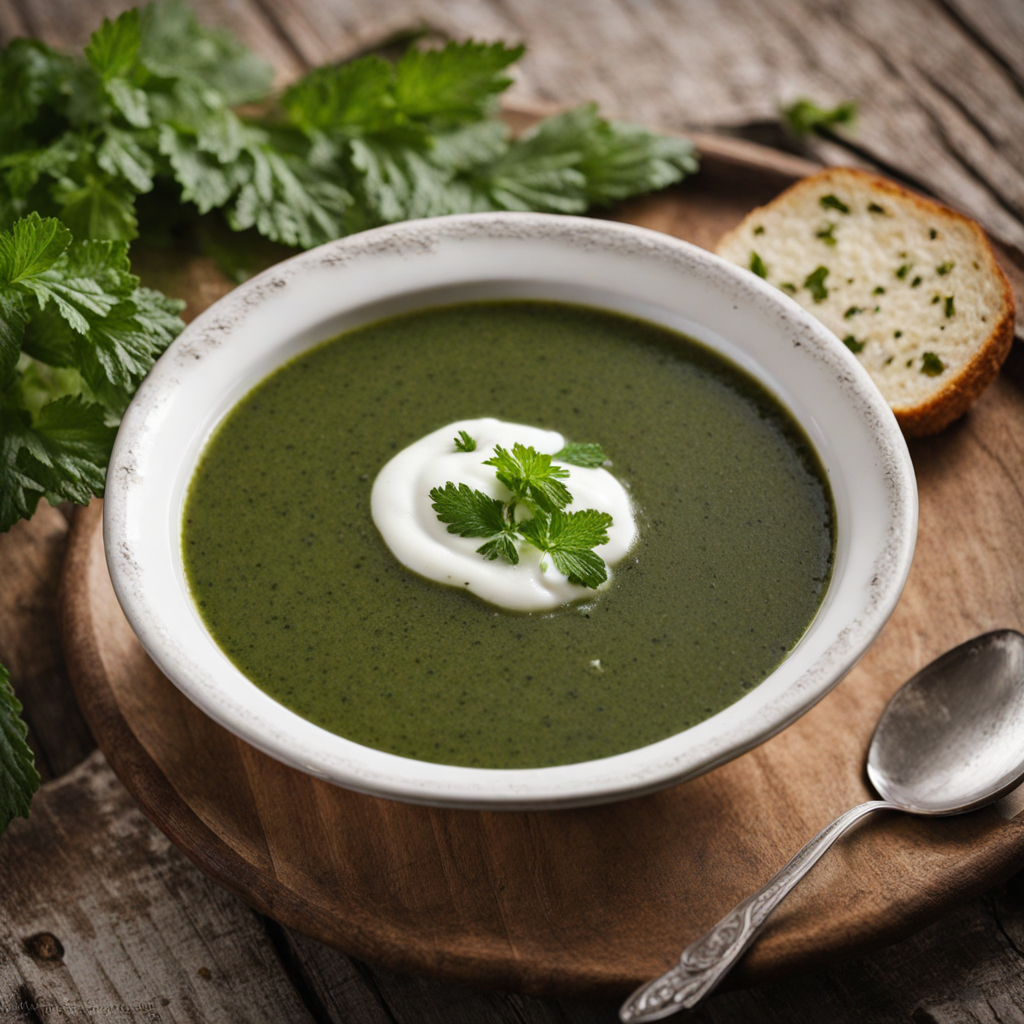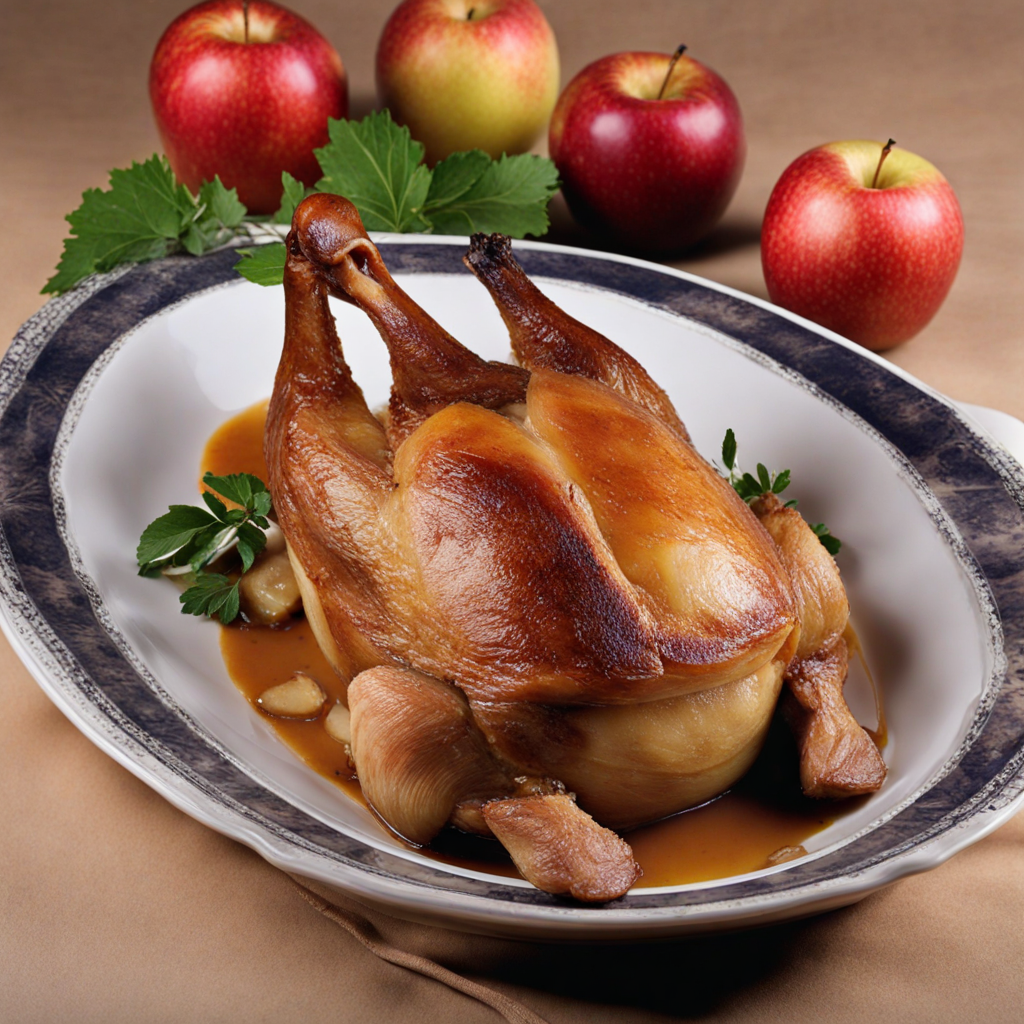Nettle Soup
Nettle soup, a beloved dish in Estonia, is a vibrant and nourishing creation that highlights the unique flavors of foraged ingredients. Made primarily from fresh stinging nettles, this soup is a delightful representation of the Estonian culinary tradition, which often embraces seasonal and wild produce. The bright green color of the soup is visually striking, evoking the lush landscapes of Estonia during springtime when nettles are at their peak. The cooking process involves gently simmering the nettles with potatoes and onions, allowing the flavors to meld beautifully while retaining the fresh, verdant essence of the greens. The soup is typically seasoned with a touch of salt, pepper, and sometimes a hint of cream or sour cream, which adds a creamy richness that balances the earthy notes of the nettles. As you take your first spoonful, you'll experience a subtle, grassy flavor that is both invigorating and comforting. The addition of potatoes contributes a satisfying heartiness to the dish, making it perfect for a light lunch or an appetizer. Some variations might include herbs like dill or parsley, enhancing the freshness and adding complexity to the overall taste. Nettle soup is not only delicious but also packed with nutrients, making it a wholesome choice for health-conscious eaters. The stinging nettle, often viewed as a pesky weed, is rich in vitamins and minerals, offering an earthy flavor that is surprisingly delightful. Enjoyed warm, this soup embodies a connection to nature and the Estonian way of life, where foraging and utilizing local ingredients are celebrated. Whether served with a slice of rye bread or enjoyed on its own, nettle soup is an exploration of taste that invites you to savor the essence of Estonia's culinary heritage.
How It Became This Dish
Nõgesesupp: The Essence of Estonian Culinary Heritage Nõgesesupp, or nettle soup, is a traditional dish deeply woven into the fabric of Estonian culinary history. This simple yet nourishing soup showcases the resourcefulness of Estonian cuisine, which has evolved over centuries in response to the region's climate, agriculture, and cultural influences. As we explore the origins, cultural significance, and development of Nõgesesupp, we uncover a dish that reflects both the harsh realities and the rich traditions of Estonian life. #### Origins and Historical Background The history of Nõgesesupp can be traced back to the agrarian roots of Estonia, where the reliance on seasonal ingredients shaped the local diet. Nettles (Urtica dioica) have been a staple wild green in many European cuisines for centuries, revered for their nutritional properties and versatility. In Estonia, nettles have long been collected in spring, marking the arrival of warmer weather and the promise of new life after the long, harsh winters. For Estonians, spring is a time of renewal, and gathering wild greens has historically been a communal activity. Families would venture into the fields and forests to forage for young nettles, which are tender and flavorful before they mature and become tough. The practice of foraging not only provided essential nutrients in the form of vitamins A and C, iron, and protein but also fostered a sense of connection to the land and the cycles of nature. #### Cultural Significance Nõgesesupp holds cultural significance beyond its nutritional value. It is a dish that symbolizes sustainability and the importance of utilizing local resources. In a country with a strong connection to nature, the act of foraging for nettles embodies Estonian values of self-sufficiency and environmental stewardship. Traditionally, Nõgesesupp is served in spring, coinciding with the season's first harvests, and is often enjoyed during celebrations of Estonian identity, such as Jaanipäev (Midsummer Day) or other folk festivals. The soup is more than a mere dish; it carries with it the stories and traditions of generations. Elders often pass down recipes and tips for preparing Nõgesesupp, emphasizing the importance of using fresh ingredients and traditional methods. In this way, the soup acts as a vessel for cultural memory, linking the past with the present. Many Estonians reminisce about their childhood, recalling the joy of gathering nettles with family or the comforting aroma of the soup simmering on the stove. #### Ingredients and Preparation The ingredients for Nõgesesupp are simple yet reflective of the Estonian palate. The primary component, of course, is the nettle itself, which is typically harvested in early spring when the leaves are young and tender. Other common ingredients include potatoes, onions, butter, cream, and sometimes hard-boiled eggs. The soup can be seasoned with salt and pepper, and occasionally enriched with a splash of lemon juice or vinegar for acidity. The preparation of Nõgesesupp involves a straightforward process. First, the nettles are thoroughly washed to remove any dirt or insects. They are then blanched briefly in boiling water to reduce their sting and enhance their vibrant green color. In a separate pot, onions and potatoes are sautéed in butter until fragrant and tender, after which the blanched nettles are added along with vegetable or chicken stock. The soup is simmered until all the ingredients are cooked through, and a splash of cream is added just before serving. This dish is often garnished with a sprinkle of fresh herbs or a dollop of sour cream, showcasing the Estonian preference for rich, creamy flavors. The result is a vibrant, hearty soup that is both comforting and nourishing—a true reflection of Estonian culinary traditions. #### Evolution Through Time As Estonia's political landscape has shifted throughout history, so too has its culinary identity. The influence of various ruling powers—from the Danes and Swedes to the Russians—has shaped Estonian cuisine, introducing new ingredients and cooking techniques. However, despite these changes, traditional dishes like Nõgesesupp have persisted, often adapting to incorporate new flavors while maintaining their core essence. In the 20th century, as Estonia experienced both independence and Soviet occupation, the availability of ingredients fluctuated, leading to variations in traditional recipes. During times of scarcity, nettles became even more valuable as a food source, leading to increased use in everyday cooking. In contrast, the post-Soviet era saw a resurgence of interest in traditional Estonian cuisine, with chefs and home cooks alike rediscovering Nõgesesupp and other heritage dishes. Today, Nõgesesupp is celebrated not only as a beloved traditional dish but also as a symbol of Estonia's culinary renaissance. Contemporary Estonian chefs have taken the classic recipe and given it new life, experimenting with flavor pairings and presentation while honoring the dish’s roots. In urban centers like Tallinn, Nõgesesupp can be found on the menus of upscale restaurants, showcasing its adaptability and relevance in modern gastronomy. #### Modern Significance and Sustainability In the context of contemporary food movements, Nõgesesupp embodies the ideals of sustainability and locavorism. As awareness of the environmental impact of industrial agriculture grows, many people are looking to traditional foraging practices as a means to reconnect with their food sources. Nettles, once deemed a nuisance by many gardeners, are now celebrated for their nutritional benefits and culinary potential. Additionally, Nõgesesupp serves as an educational tool in the promotion of foraging and the appreciation of wild foods. Workshops and foraging tours are increasingly popular in Estonia, teaching participants how to identify, harvest, and prepare wild edibles. This trend reflects a broader global interest in reconnecting with nature and understanding the origins of our food. #### Conclusion Nõgesesupp is more than just a soup; it is a reflection of Estonia's cultural heritage, resilience, and deep connection to the land. From its origins as a simple peasant dish to its modern-day interpretations, this nettle soup encapsulates the essence of Estonian culinary traditions. As we continue to explore and celebrate the flavors of the past, Nõgesesupp stands as a testament to the enduring legacy of foraging, sustainability, and the joy of sharing food with loved ones. In every bowl of Nõgesesupp, one can taste the history and spirit of Estonia—a country that embraces its roots while looking toward the future.
You may like
Discover local flavors from Estonia







